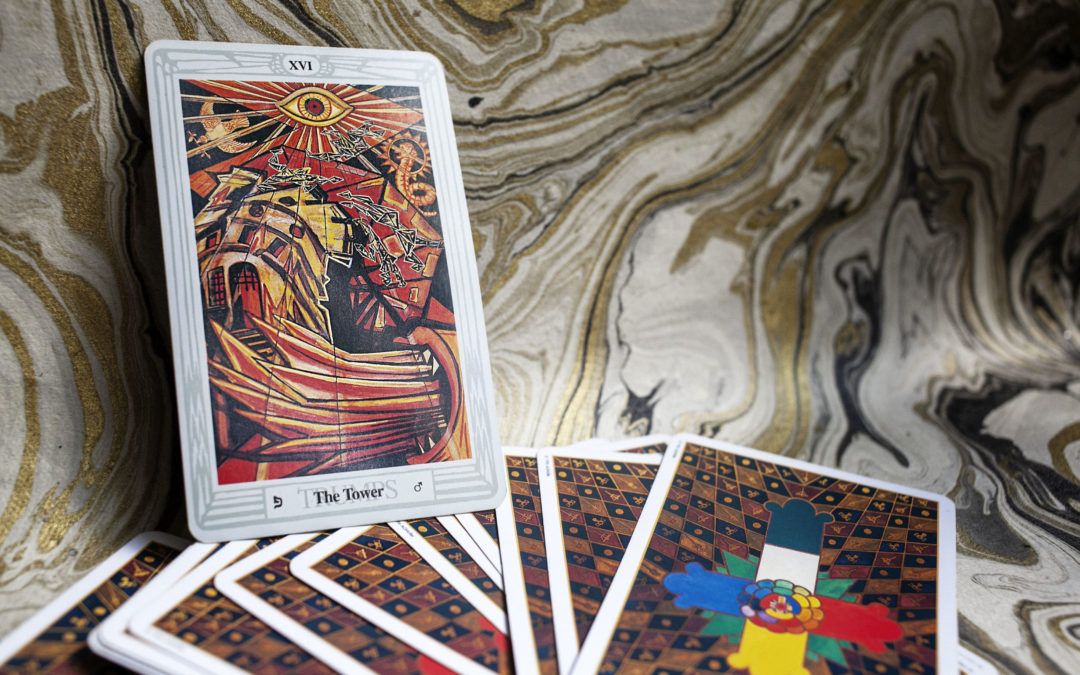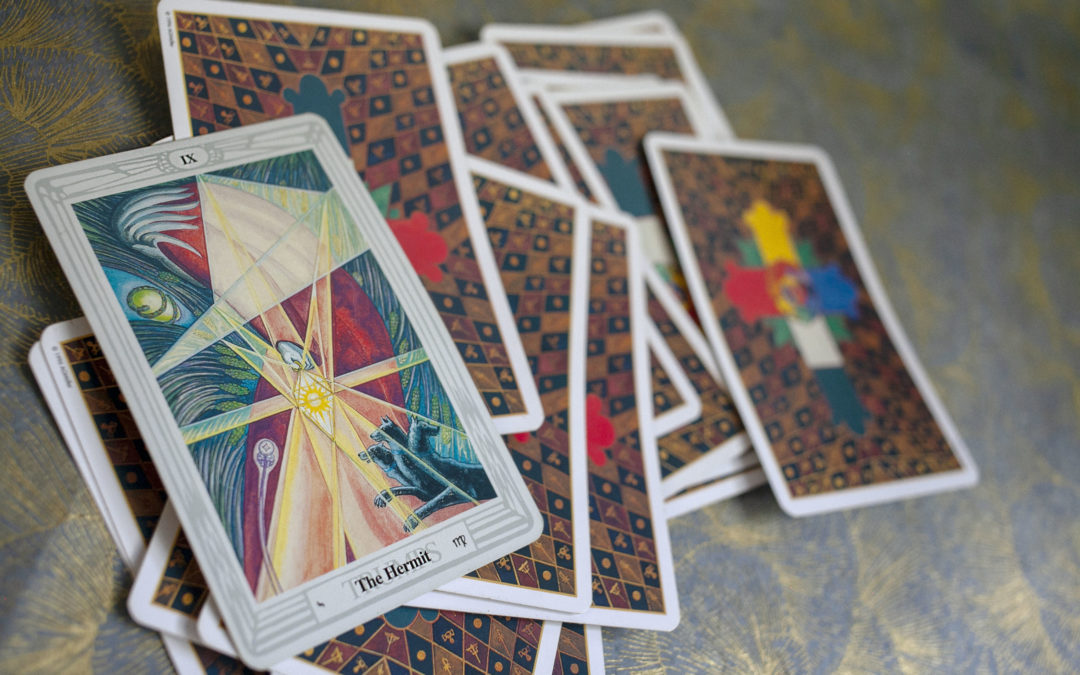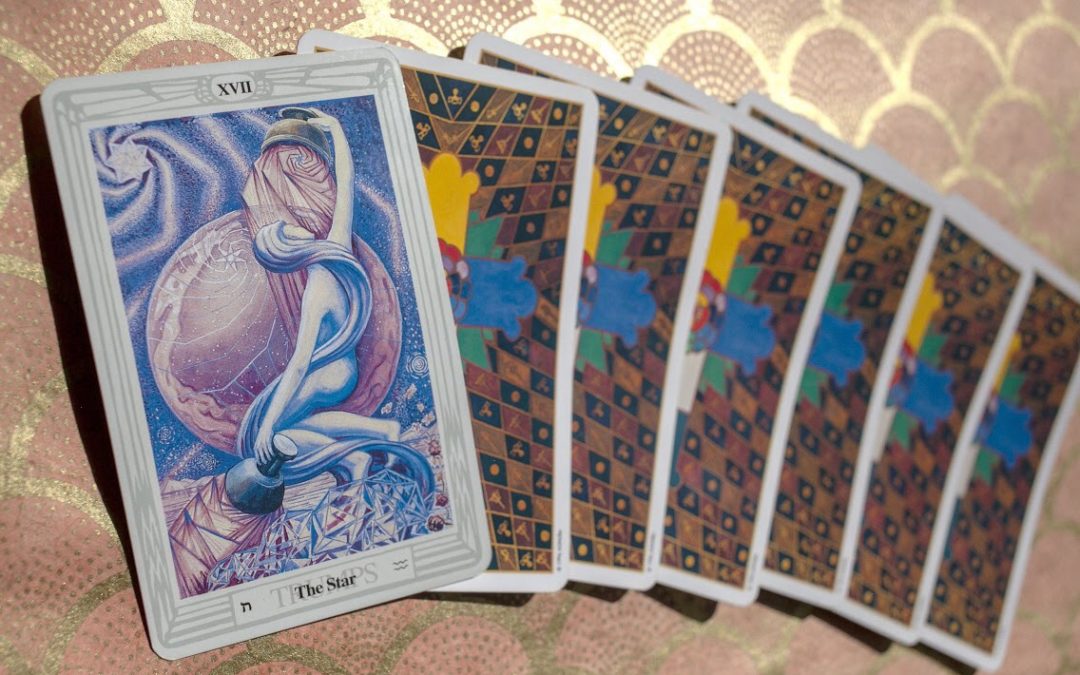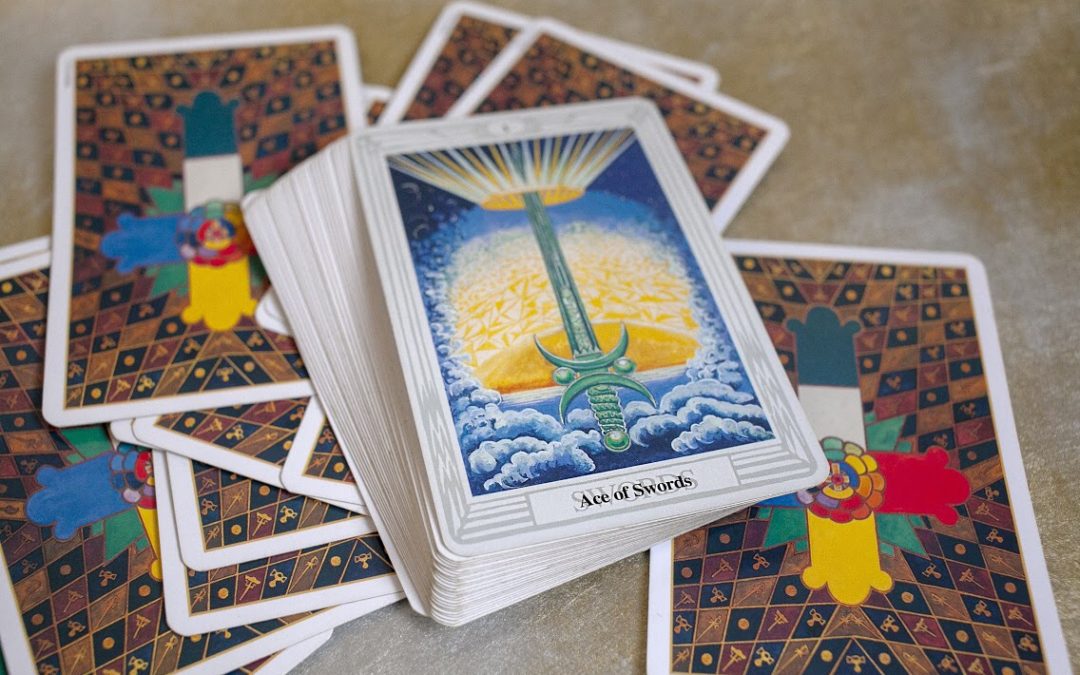
by Kosmic Tonic | Aug 8, 2019 | Tarot
Six months ago, close to the previous eclipses along the Cancer-Capricorn axis, Jasmine and I wedged our way through a shaft of the Great Pyramid at Giza. Tourists wilted on all sides from over-exertion or claustrophobia or heat stroke — it must have been a hundred degrees inside. Jasmine and I had experienced a few underworld journeys by this point in the trip, including a low-key syncopic seizure on my part that necessitated a trip to an airport hospital. By the time we squeezed our way back to the sunlight, salt crusting our foreheads from the sweat, hair dishevelled, eyes blinking out dust, we referred to the pyramid, wryly, as our birth canal.
The first card Jasmine and I drew, when we launched an earlier iteration of our website, was the Tower card. In some ways, it’s haunted us: that terrible tube-mouth, flashing out shards of fire, the tower itself cubist and fragmented, as if viewed from the reflection of a broken mirror. The eye of Horus, the anonymous angular shadows — inhuman in form, but like origami window jumpers. The entire card burning and bloodshot and red.
Whose heart doesn’t sink when they pull this card?
The astrological correspondence for this card is planetary Mars. Mars as fire, initiation, battlefield, destruction. In the sequence of the major arcana, the Tower follows the Devil, who is represented by the sign of Capricorn. Capricorn brings us stability, ninety degree angles (of walls and the roofs over our heads), systems, authority. The Tower card portrays the old system burning — Mars undiscriminating in its fire, with a drive only to level.
The author at Esoteric Meanings describes the Tower as the “glyph for the process of PURIFICATION THROUGH FIRE.” And that’s another way of understanding this Mars. The Hebrew letter assigned to this card is פ (pe), or mouth. But the mouth does not devour from hunger or avarice. Nor is the violence inspired from cruelty — no more than a natural forest fire or earthquake. A tide of destruction follows the tide of reaping as surely as winter follows harvest.
Sometimes, the structures we have leaned on need replacing, and the only way to do so is light a match. It’s uncomfortable. It might be wildly painful, at times. But it’s a re-birthing, too. This card turned out to be a fair representation of our journey so far, culminating (a year after we pulled it) with Jasmine’s study of the Qabalah, and her interpretation of this card as an internal alchemical process — indeed an alchemy of the soul. (For more on this, check out Jasmine’s recent talk at the Fresh Voices in Astrology Summit.)
Religions around the world include a form of ritual purification, whether to initiate the believer into the religion (such as a Christian baptism), or smudging to clear a space, or banishing, or carefully washing the body before prayer. We might think of Mars this way, as the knife that removes the tumour, or a flame that sterilizes the needle (or our etheric bodies / inner worlds.) In the Book of Thoth, Aleister Crowley compares this card to Shiva the Destroyer, who dances upon the bodies of his devotees. Crowley explains:
Briefly, the doctrine is that the ultimate reality (which is Perfection) is Nothingness. Hence all manifestations, however glorious, however delightful, are stains. To obtain perfection, all existing things must be annihilated.
Sounds extreme, but sometimes complete severance from the past (especially toxic habits, people, influences) is exactly what is required.
The next card in the sequence is the Star, which signals the return of hope, light, wonder and awe. Crowley concludes his chapter on the Star with words from Nuit, the goddess featured on the card, pouring water between two cups: I give unimaginable joys on earth: certainty, not faith, while in life, upon death; peace unutterable, rest, ecstasy; nor do I demand aught in sacrifice…Sing the rapturous love-song unto me! Burn to me perfumes! Wear to me jewels! Drink to me, for I love you! I love you! I am the blue-lidded daughter of Sunset; I am the naked brilliance of the voluptuous night-sky.
After all, a tide of sewing follows the tide of destruction once more.

by Kosmic Tonic | Apr 29, 2019 | Tarot
No matter what deck you use, the Hermit never seems to look at you head-on. In this version, he buckles into the wheat, face barely even in profile. His hand forms the centre of the card, which is appropriate, given the Hebrew letter associated with the Hermit is Yod (י), which translates to “hand.” This letter has been said to represent the “divine spark”: “the first dot with which the scribes first start writing a letter, or the last dot that gives a letter its final form,” according to the Likutei Maharan.
The grapheme of the Yod, that diminutive tick, forms the foundation of all Hebrew letters—as all written words begin with a hand.
I’ve always associated the sign Virgo with the hand: the hand writing or weaving, the precision and sensitivity of our fingers, which no machine can quite replace or replicate. Our hands opened in offering or clasped in prayer or simply feeling forward. The astrological correspondence of this card is, indeed, Virgo. When that thought truly landed for me, it changed how I conceived the word virgin.
It has been said that the pre-patriarchal definition of “virgin” described someone who was independent and self-sovereign. This theory resonates, though I can’t find a historical or etymological backing for it. In all likelihood “virgin” from “virgo” described simply a girl.
Today, the words Hermit and Virgin both suggest someone un-coupled, in a state of seclusion or retreat. The only difference is we conceive the virgin as somehow in-waiting, “eligible.” If we divorce, for the moment, chastity from the idea of goodness (and from the quasi-imperial fetishization of conquering “unspoilt” or “unclaimed” bodies), Virgin and Hermit are the same. Both turned from the world, maybe inward or upward, or backward or forward, like the 3-headed Cerberus on this card. But importantly: not at you.
Demetra George has written of Vesta as complete-in-herself, her libido flowing divinely upward rather than to another person. And here enters an alternative understanding of the Hermit: as priestess or seeker. The Fool on her journey toward knowing. In the language of witchcraft, new students are described, simply, as seekers.
Though I understand the hesitation to conflate signs with houses—and assume co-equivalence between Virgo and the 6th house—there is a meaningful echo here. I connect the 6th house to ritual: the humility of sweeping a practice space, cleaning the altar, polishing the chalice. Opposite the 6th is the 12th house: that space of seclusion and study, shadow work, occasional dark nights.
Aleister Crowley connects this card to the Persephone story. He evokes Mercury (ruler of Virgo) as Psychopomp, our guide into Other or Underworlds. This is a common theme: the virgin (or seeker or hermit) entering the shadow realm, the nether regions of their mind or spiritual quest. In the story, Ceres / Demeter destroys our crops in her rage and grief and desperation to return her daughter from Hades. She’s successful, in part. But Persephone, as we knew her, has changed. She’ll return to the underworld again next winter, and with her, the crops will freeze. Interesting, the background of wheat in this card, especially when you note that the brightest star in the constellation of Virgo is Spica, which is Latin for “ear of grain.”
According to Crowley, this card represents fertility in its most exalted sense, not to be mistaken with the narrow, procreative definition of the word. Rather, he means fertility as potential, more perfect because it is unformed. Fertility as yod or hand or divine spark. And so, I can’t see the Virgin as a maiden-in-waiting or a glorified Bachelorette. She’s the Hermit, the Nun, the Priest, the Thinker, the Creatrix, hands busied in weaving, writing, offering and prayer.

by Kosmic Tonic | Mar 23, 2019 | Tarot
Here we find Nuit / Nuith / Nut, the Goddess of Night in her manifest (that is, physical) form. We studied this figure in our exploration of the Aeon card, which featured Nuit in her “formless form,” back-bending in infinite space over Horus. That tension between form and formlessness feels appropriate for the major arcana card that corresponds to Aquarius: a sign of the least embodied element (air), ruled by Saturn, who deals in structure.
As in the Rider-Waite-Smith rendition of the card, the sign Aquarius arrives in the shape of the water bearer: the figures in both decks occupied in the labour of pouring. In the R.W.S. version, the woman kneels with one foot on the earth, the other under-water, implying a bridge between form and formlessness, or boundaries and boundaryless-ness. I’ll come back to this bridge, for it captures something of the essence of Aquarius.
Crowley linked this card to the Hebrew letter heh, which means window. As the author at Esoteric Meanings points out, a window’s main function is to transfer light: like the stars (or our stars, the sun.) When considering the sign of Aquarius, I am taken with how light might also represent knowledge or “enlightenment.”
The R.W.S. version of this card features an eight pointed star, which is mythologically associated with the Star of Ishtar or Inanna (and thereby Venus.) This makes sense for an astrologer, because we know planetary Venus draws her own star around the ecliptic in eight year cycles. Crowley’s star has seven points, which is known as the Elven or Fairy star (and used as a symbol of the A.A, the inner order of the O.T.O., of which Crowley was one of the most famous members.) Again, as an astrologer, I associate seven with the planet Saturn, the 7th “wandering star” counted in traditional astrology. Of course, we also count his cycle in seven year increments, or Saturn squares. Interestingly, Crowley links the seven-pointed star to Venus as well, as Venus rules the 7th sphere on the Tree of Life: Netzach.
This blurring between Venus and Saturn feels significant, as it catches on the inherent tension of this card, one of the most aesthetically “feminine” and nocturnal in the deck, though it correlates to a traditionally “masculine” and diurnal sign. In his Book of Thoth, Crowley describes the water in the background of this card as the “great sea of Binah,” the 3rd sphere on the Tree of Life, which relates to intuitive understanding, contemplation, and the womb that gives shape to the spirit of God. What is the planet we associate with this sphere? None other than Saturn.
That Saturn might be considered a feminine planet is not a new concept in astrology. In the Hellenistic text, Carmen Astrologicum, Dorotheus says: “…the feminine planets are Saturn, Venus and the Moon, the masculine ones are the Sun, Jupiter, and Mars.” Though Dorotheus is the only astrologer who asserts the femininity of Saturn (to my knowledge), the notion does offer a pleasing symmetry between the nocturnal / diurnal and masculine / feminine planets. For more information on the theory of Saturn as a feminine planet, and particularly Saturn as Crone, check out Charles Obert’s excellent discussion on the subject at Student of Astrology.
This polarity between diurnal and nocturnal is further represented on the card between the gold and silver chalices: the former, solar, the latter lunar, or even Saturnian. Indeed, this imagery calls to mind the axis between sun-ruled Leo and his opposite: wintry, Saturn-ruled Aquarius. As suggested earlier, there is an inherently bridging quality in the archetype of Aquarius. Many Aquarians I know take for granted the assumption (radical for some) that we should share, cooperate, freely exchange our efforts and our ideas. On the one hand, Aquarius is independent, free-spirited, intellectually expansive, as represented by the Air element. On the other hand, Aquarius is fixed in belief, tethered to logic, if their own, ingeniously innovated. This sign is the water-bearer, but not water. Aquarius conveys the water of knowledge in the Saturn structure of two vessels or cups.
In his Book of Thoth, Crowley suggests that to understand this card, one must understand the first chapter of the Book of the Law, which chronicles the manifesting of Nuit and her masculine counterpart, Hadit. Several lines from this text underline the divinity and uniqueness in all of us, another egalitarian (and Aquarian) concept. Crowley writes: “every man and every woman is a star,” and later: “For he is ever a sun, and she a moon. But to him is the winged secret flame, and to her the stooping starlight.” In the mouth of Nuit, Crowley continues: “I am the blue-lidded daughter of Sunset; I am the naked brilliance of the voluptuous night-sky.”
In addition to heh, The Star has been linked to the Hebrew letter tzaddi, which means fish hook. Traditionally, tzaddi has also been assigned to the Emperor, and the two cards appear interchangeable in the Golden Dawn list of correspondences. In The Law is For All, Crowley writes: I see no harm in revealing the mystery of Tzaddi to ‘the wise’; others will hardly understand my explanations. Tzaddi is the letter of The Emperor, the Trump IV, and He is the Star, the Trump XVII. Aquarius and Aries are therefore counterchanged, revolving on the pivot of Pisces, just as, in the Trumps VIII and XI, Leo and Libra do about Virgo. This last revelation makes our Tarot attributions sublimely, perfectly, flawlessly symmetrical.
I won’t spend more on the Golden Dawn correspondences between the Hebrew letters and the tarot keys, but again I find it worth pausing on, this symmetry and swapping between genders: The Star for the Emperor; the Goddess of Night as Aquarius; the womb, Binah, as Saturn. It does feel appropriately Aquarian, this defying of convention, at once rigid in its logic and contra-normative.
Angeles Arrien’s description for The Star quotes Heidegger, who says: “a person is not a thing or a process, but an opening through which the Absolute can manifest.” Arrien elaborates on this sentiment: “the Star card reminds us that each of us is an opening for light, or a gateway through which the Absolute can manifest.” That is God, or divinity, or Spirit.
If any sign recognizes the divinity in all of us, and the collective light that pools when we work together, it is Aquarius. And maybe that contributes to the feminine thread of Saturn: the wise woman goddess who sees herself reflected in you, the womb as a pliant container for life, but ultimately, still a structure.
References:
Liber AL vel Legis by Aleister Crowley
The Book of Thoth by Aleister Crowley
The Law is For All by Aleister Crowley
Student of Astrology by Charles Obert
Esoteric Meanings

by Kosmic Tonic | Mar 19, 2019 | Tarot
This card is attributed to the letter Nun, which means fish; the symbol of life beneath the waters; life traveling through the waters.
So begins Crowley’s interpretation of the Death card. Ever a contrarian, he opens with an emphasis on life.
This card is represented by the sign of Scorpio, as indicated by the scorpion on the bottom right. Though the planet Saturn has no relation to Scorpio, his symbolism is prominent in this card: the skeleton figure, every bit the Grim Reaper, and his scythe. Saturn may be the lord of death among astrologers, but he also represents structure and form. Death has a way of dissolving, or defying both.
Crowley’s Death figure is unlike other decks’ representations in that he wears the helmet of Osiris. Osiris, Lord of the Underworld, brother-husband to Isis, unceremoniously dismembered by their younger brother, Set.
In this card, he dances a gruesome jig, his legs forming the sigil of planetary Saturn (♄). In the Middle Ages, a fixation on death (possibly due to the plague) inspired representations of the “dance of death,” or danse macabre, in literary and visual art: a parade of live and dead figures wiggling toward their doom. The figures were arranged by rank: from Pope and Emperor to child or clerk, all cavorting to the same loading dock, as it were. These images captured that certainty and impartiality of death; in so much Saturn represents hierarchy and authority figures, Death further suggests his undoing.
Crowley’s Death card also indicates the three “levels” of Scorpio:
- the scorpion
- the fish or snake (painted in almost the same brush stroke)
- the eagle (featured in the top left, above Osiris’ head)
I encountered this archetype of Scorpio-as-Eagle early in my studies of astrology, and it always threw me for a loop. However, the archetypes are explained in the astronomy: the constellation Scorpius sits beside Ophiuchus, “the serpent bearer,” and Aquila the eagle.
The scorpion archetype represents the primal, bottom-feeding, even self-destructive urges of this sign. The earthbound Mars energy that thinks with his… root chakra. An (unsubstantiated) myth of scorpions in nature suggests that they’ll sting themselves in the head if surrounded by a ring of fire. The Scorpion “level” of Scorpio may not sound very flattering, but it’s necessary. We would be nowhere with our basest urges to eat, protect ourselves, procreate.
The fish or snake represents the regenerative quality of Scorpio. The fish was understood as a symbol of rebirth in Egyptian mythology, especially the tilapia, who carry eggs in their mouths until they hatch. Then of course there’s ichthys, the fish symbol for Christ. Snakes too embody the idea of rebirth and transformation: after all, they shed, and re-grow, their own skin. And as Esoteric Meanings eloquently words it: life and death are two curves of the same serpent.
The final “tier” of Scorpio is the least intuitive: the Eagle. Deborah Houlding writes compellingly of this archetype: If, as the Egyptians thought, scorpions represent initiation into the sacred mysteries, we can consider the sign’s other related creature, the eagle, as a higher expression of Scorpio power…Transcendence from the crawling scorpion to the soaring eagle, still predatory, still conveying the essence of patience and penetration, but capable of flight and height, brings together the theme of destruction and renewal as a story of evolution.
From the earthly urges of the scorpion, through the regeneration of the fish / snake, to transcendence, the soaring eagle, and access to the mysteries: the sign Scorpio and the card Death contain all three. And it may not present as a gradation, or an evolution: we can engage on all three planes at once. And we do.
When this card turns up, consider the forms or structures or habits you are releasing. Know that transformation may involve a journey into the dark. It may involve detachment and letting go of what we perceive to be important, but an Eagle (or phoenix) awaits you on the other side. Only through certain sewer journeys do we find constructive change, necessary shedding, and higher knowing. Maybe that’s why it’s hard to freak out a Scorpio: they have the impenetrability of experience about them. They’ve been there. Shed that. And come out (relatively) unscathed.
A Zen proverb captures this card rather bluntly: Let go, or be dragged.
References:
Esoteric Meanings
The Book of Thoth
Deborah Houlding

by Kosmic Tonic | Mar 16, 2019 | Tarot
The Ace of Swords is the root of the Air element: the purest essence of Air, which we associate with the mind, words, and law. For what is law but language? Indeed, θέλημα, or “THELEMA” is inscribed on the blade: the Greek word for “will,” or “the word of the law” for Crowley. Immediately, I think of the Sword of Justice in the Adjustment (or Justice) card. And the Queen of Swords, a head dangling from her fist. That ruthless, stone-eyed face the law can have: “blind,” in theory, for better or worse.
Some of the symbolism on this card is difficult to grasp if you’re not familiar with the Kabbalah. It is said that Air is formed from the union of Fire and Water: and so we see the sun rising from the lake or ocean, the clouds sudsing around it. Maybe you don’t need to know the Kabbalah to understand this one after all. What happens to water when we boil it?
The crown is lit by 22 rays: perhaps representing the 22 major arcana, or the 22 pathways of the Tree of Life. All of the aces correspond to Kether in the Tree: the topmost sphere, considered so sublime it’s completely incomprehensible (to us.)
A snake coils six times around the hilt, which is said to be of copper, Venus’ metal. There seems to be a symmetry implicit in that: Venus countering the violence of the sword. The crescent moons balancing the Sun on the water. We say a strong mind is “level-headed,” another word for balanced.
If you’ve dabbled in the Tarot, you’ll have noticed that many cards in the Sword suit have more negative or challenging connotations. In this deck, the Ten of Swords is captioned “Ruin,” the Five of Swords, “Defeat,” the Nine of Swords, “Cruelty,” and so on. It makes sense in a way. We only experience difficulty with our mind. As told in the old adages: “ignorance is bliss” (and so what is the opposite), or “curiosity killed the cat.” Once we turn our brains on and really examine the story we’ve found ourselves in, we get into trouble. A blue pill / red pill conundrum.
Red Pill: “a life of harsh knowledge, desperate freedom, and the brutal truths of reality.”
Blue Pill: “a life of luxurious security, tranquil happiness, and the blissful ignorance of illusion.”
The Ace of Swords seeds the air signs: Gemini, Libra, Aquarius. All of them cutting, in their way, wielding their minds as battle axes to learn, find justice (or balance), and project their ideals onto humanity.
The Ace of Swords can indicate a fresh idea. The light bulb moment. Epiphany. It is the root essence of honesty. Clear thinking. The sword severs, and this is a suit (or element) of detachment. The sword pierces the fugue of emotions. And yet, it’s not confined by the materiality of the earth element. It sees beyond corporal bodies, into the logic (and logos) of things. The Air element thinks, calculates, articulates. Articulate, from articulare, “to separate into joints.”
As the root of the Air element, the Ace of Swords seeks fairness, social justice, the truth. Another tired expression: the pen is mightier than the sword. So is the brain. Funny how the Air element represents all three.
If you surrendered to the air, you could ride it. -Toni Morrison





